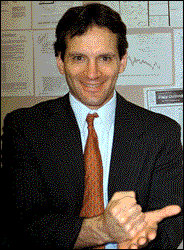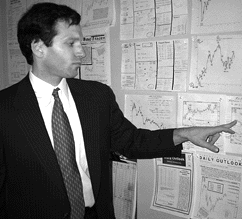Seasoned equity traders know that interest rates are a key force behind the direction of the stock market. The term "interest rates," of course, is really a catchall phrase for a group of markets that professional traders refer to as fixed income, and the most common group of those is the Treasury bond market. So what are some features that any technically based trader or investor should know about the workings of the bond market? To find out, STOCKS & COMMODITIES Editor Thom Hartle spoke with Alex Saitta, technical analyst and vice president of Salomon Brothers, via telephone on December 20, 1996, covering such subjects as intermarket relationships, the importance of testing trading theories and more.

"When I read my first technical book, it was filled with so many profitable examples that I thought any of those methods would make me a million dollars. But after I did many rigorous tests, I realized most of those methods were going to land me in the poorhouse. -- Alex Saitta
Let's start with your background.
"I received a management degree from New York University in 1984, and shortly thereafter I went to work for Paine Webber as a sales liaison on the fixed-income trading floor. One of the brokers was a chartist, and he would look for chart patterns like head-and-shoulders, double tops. I noticed that the patterns seemed to work more often than not, which encouraged me to buy my first technical analysis book. Then, about a year later, I left Paine Webber to work for Salomon Brothers in a similar position. In 1989, I moved off the floor and into the research department and began writing a daily technical analysis report entitled Financial Markets Daily Outlook for the firm's clients, salesmen and traders."
I've been studying the markets for 10 years, and people always ask me if I'm more convinced or less convinced that technical analysis works. Honestly, I'd have to say both.
Both? How can you say both?
"Well, when I read my first technical book, it was filled with so many profitable examples that I thought any of those methods would make me a million dollars in a short time. But after I did many, many, rigorous tests, I realized that most of those methods were going to land me, and anybody who actually went for them, in the poorhouse. So in one sense I've become less convinced, but in another sense I've also become more convinced because there are a few methods or basic concepts that have proved to be profitable after rigorous testing. Unfortunately, the problem with most analysts -- technical and fundamental -- is that they all want you to take their word for it."
How about an example of something that people say is true and what your testing found?
"Sure. After the stock market crashes of 1987 and 1990, stocks and bonds moved in opposite directions for a period (Figure 1). A lot of people started talking about how stocks and bonds were inversely related, and I wanted to know if that was true. To find out, I looked at the previous 10 years of daily changes and I found that 61.6% of the time, bonds and stocks moved in the same direction. They moved in the opposite direction 34.7% of the time, and 3.7% of the time one of them was unchanged (Figure 2). So it's pretty clear that most of the time, but not always, stocks and bonds move in the same direction.
 Figure 1: Stocks and Bonds. After the stock market crashes of 1987 and 1990, stocks and bonds moved in opposite directions for a period.
Figure 1: Stocks and Bonds. After the stock market crashes of 1987 and 1990, stocks and bonds moved in opposite directions for a period.
"Interestingly, in the last 10 years when the price of the Dow Jones Industrial Average (DJIA) changed by 75 points or more, 40 times the bond and stock market moved in the same direction. Only nine times did it move in the opposite direction. But overwhelmingly, stocks and bonds move in the same direction, despite what happened in 1987 and 1990."

"Traders would be better off if they invested their time into testing a method before they ever risk their hard-earned capital."


